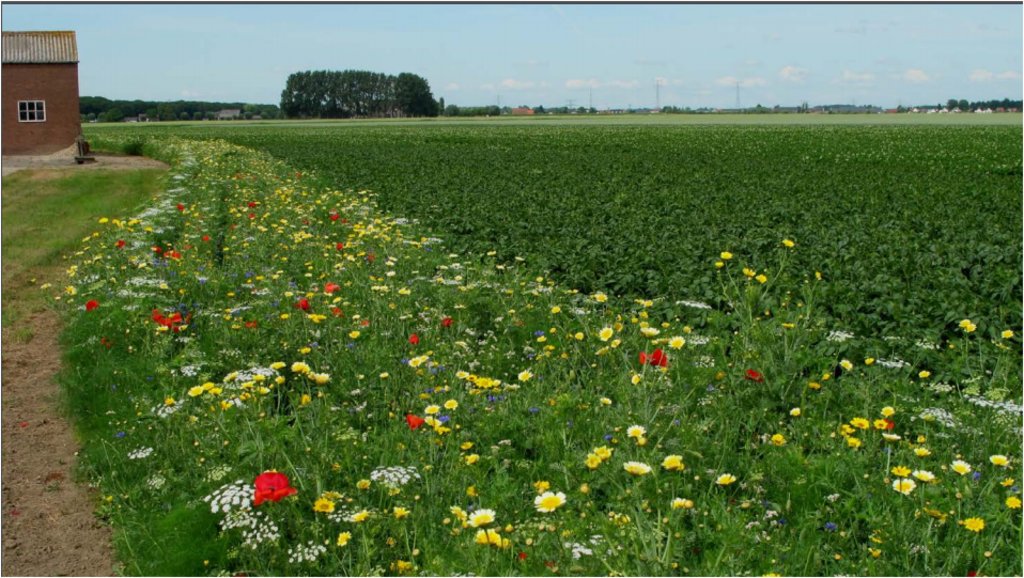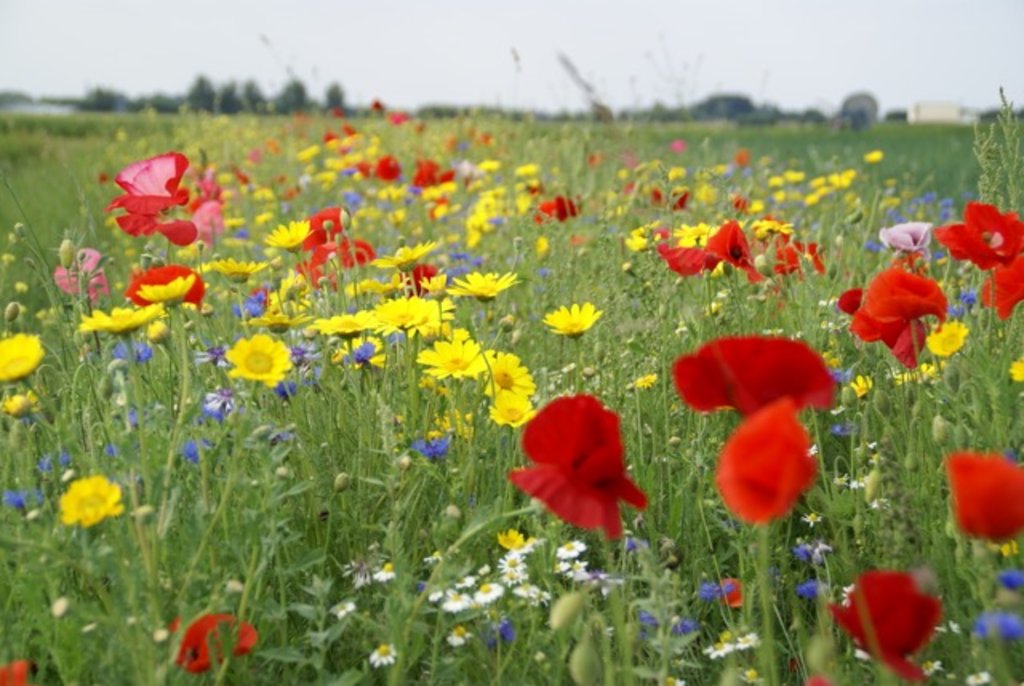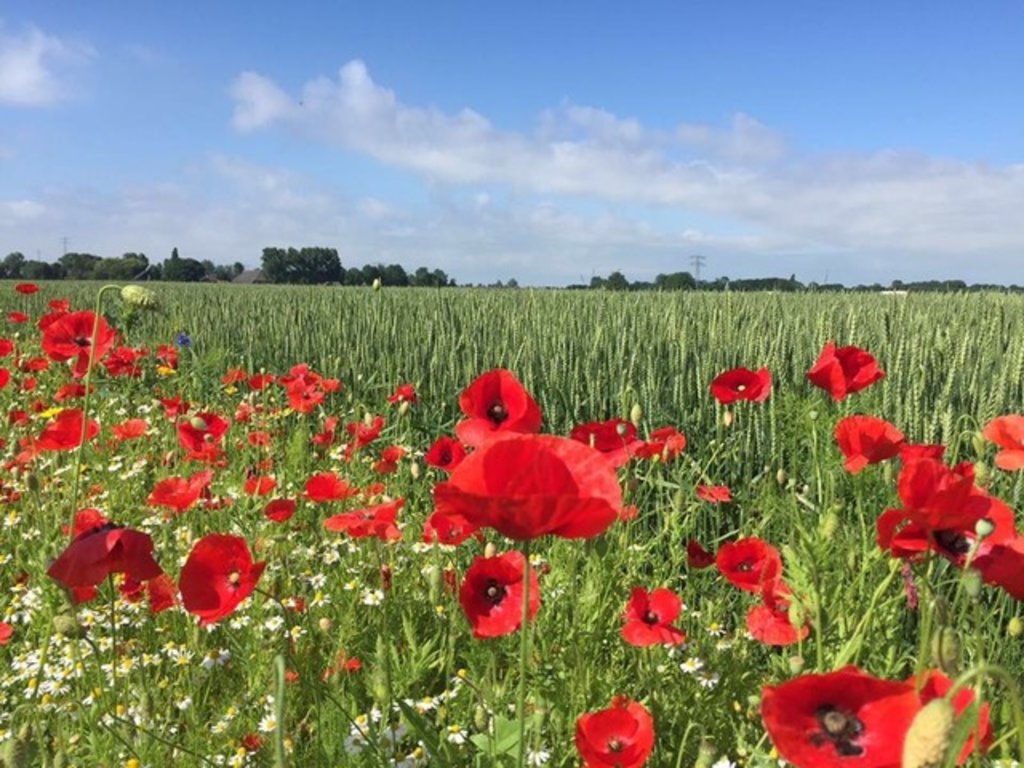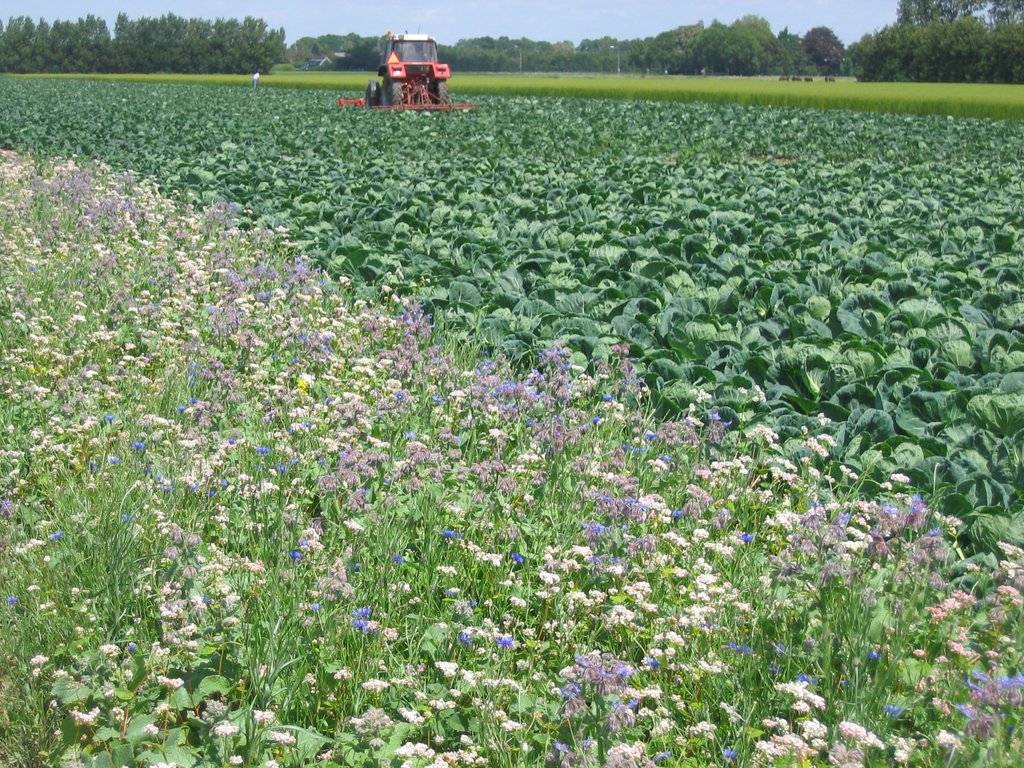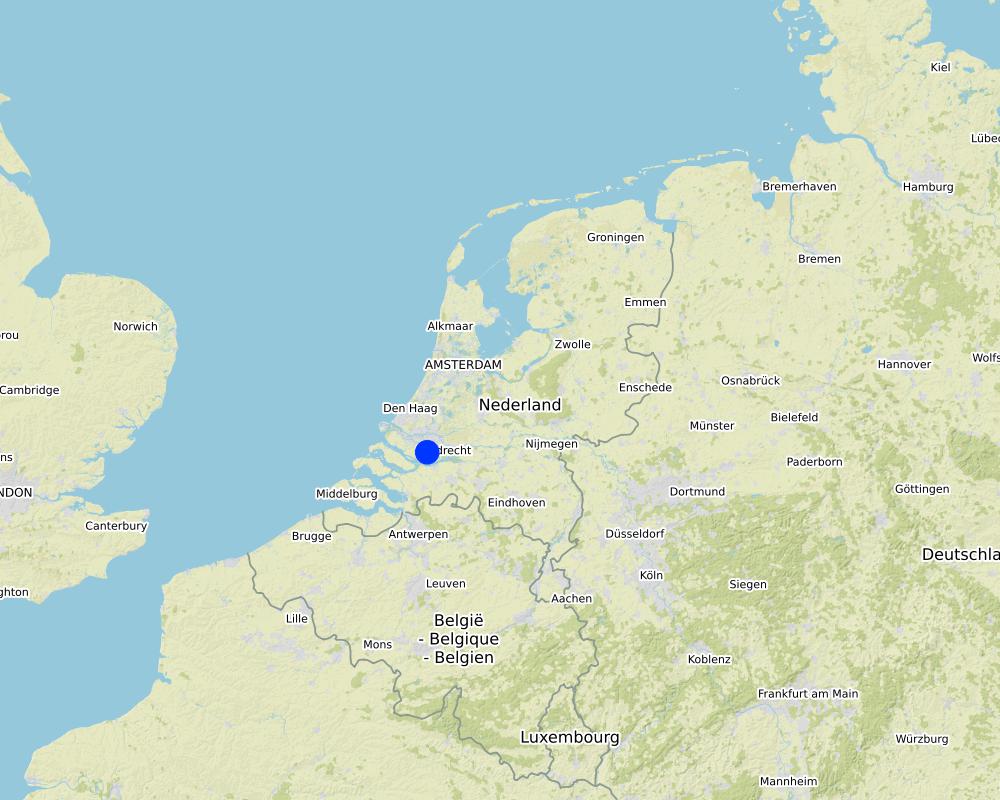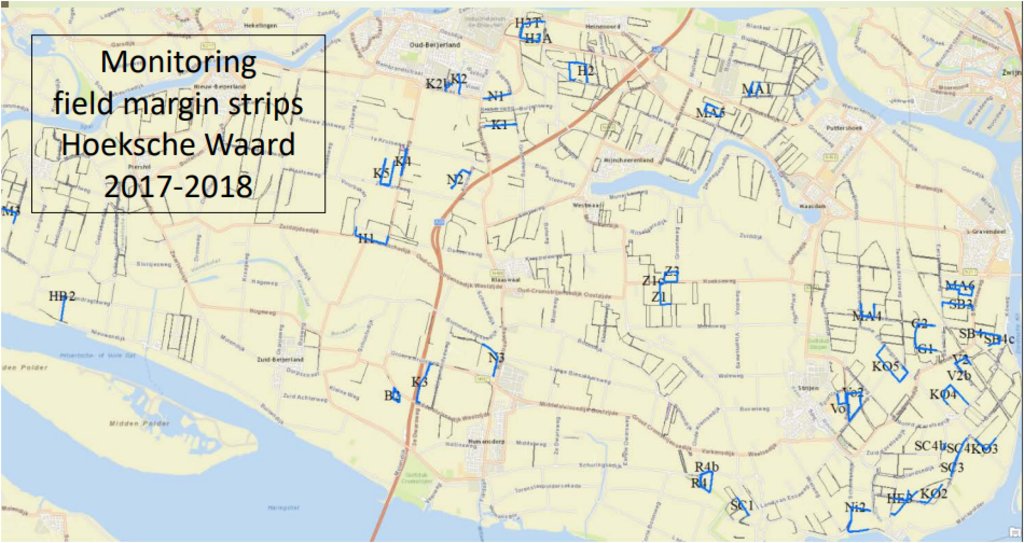Field Margin Strips [هولندا]
- تاريخ الإنشاء:
- تحديث:
- جامع المعلومات: Alan Radbourne
- المحررون: David Robinson, David Norris, Sabine Reinsch
- المراجعون: Renate Fleiner, Rima Mekdaschi Studer
Akkerrand
technologies_5187 - هولندا
عرض الأقسام
توسيع الكل طي الكل1. معلومات عامة
1.2 تفاصيل الاتصال بالأشخاص الرئيسيين لمصدر المعلومات والمؤسسات المشاركة في تقييم وتوثيق التقنية
الشخص (الأشخاص) الرئيسي لمصدر المعلومات
جامع المعلومات المشارك:
Van Rijn Paul
University of Amsterdam, Institute of Biodiversity and Ecosystem Dynamics (IBED)
هولندا
مستخدم الأرض:
Klompe Mellany
Klompe Grondbeheer
هولندا
اسم المشروع الذي سهّل توثيق/تقييم التقنية (إذا كان ذلك على صلة)
European Interreg project FABulous Farmersاسم المؤسسة (المؤسسات) التي سهلت توثيق/تقييم التقنية (إذا كان ذلك على صلة)
UK Centre for Ecology & Hydrology (CEH) - المملكة المتحدة1.3 الشروط المتعلقة باستخدام البيانات الموثقة من خلال WOCAT
يوافق جامع المعلومات والشخص (لاشخاص) الرئيسي لمصدر المعلومات على الشروط المتعلقة باستخدام البيانات الموثقة من خلال WOCAT:
نعم
1.4 إعلان بشأن استدامة التقنية الموصوفة
هل التقنية الموصوفة هنا تمثل مشكلة فيما يتعلق بتدهور الأراضي، بحيث لا يمكن إعلانها تقنية مستدامة لإدارة الأراضي؟:
كلا
2. وصف تقنيةالإدارة المستدامي للأراضي
2.1 وصف مختصر للتقنية
تعريف التقنية:
Create strips with flowering plants in the margins of arable fields.
2.2 وصف تفصيلي للتقنية
الوصف:
In the Hoeksche Waard area (Netherlands), field margin strips between 2 and 20 meters wide have been sown in the margins of arable or vegetable crop fields with a mixture of native flowering plant species, with plant species targeted to encourage certain target insect abundances. A mixture of annual flowers are sown in spring (April or May), or perennial plant mixtures (flowers and grasses) sown also in spring, or prefernetially in late summer (September). Annual flower strips produce flowers mostly in summer, whereas perennial strips produce mostly flowers in the following spring and following years.
The purpose of flower strips is to support the natural pest control and pollination by native insect species for reduced disease and increased production. Many flying natural enemies of pests require pollen and/or nectar in the adult stage for survival and reproduction, needing food on a regular basis, so must be in short range from the crop fields, i.e. in the margin of or within the field. Pollinators also need food when the crop is not flowering in order to build up a local population.
For the implementation of field margin strips to be successful, knowledge of the plant species mixtures was requried to know what would grow well in this semi-humid, deep heavy soil, agricultural environment, as well as growing well together with the right characteristics to support the target insect groups. For example, most natural enemies have small mouth parts and can only feed on nectar from shallow flowers, thus require a specific seed mix (<2 cm deep, see Van Rijn & Wäckers, Journal of Applied Ecology 2016). Here, the species were selected for their ability to support natural enemies of aphids (such as hoverflies) or wild bees, especially bumblebees. The first group includes flowers with accessible nectar (< 2 cm deep) such as Apiaceae, buckwheat, cornflower, and Asteraceae with shallow florets. The second group includes red clover, lotus and other Fabaceae, as well as Asteraceae with deeper florets (such as sunflowers). Perennial mixtures are generally supplemented with annual flowers (cornflowers and poppies) that already produce flowers the first year, as well as (slow growing) grass species (Festuca) to make the strips more robust when incidentally used as tractor paths.
Additionally for implementation, knowledge on how to effectivly use the seed sowing machines, with special care required for preparing the seed bed in advance, to prevent segregation of bigger and smaller seed in the machine, and for sowing the seeds not to deep and the field margin strips should be maintained for a number of years to allow for a local build up of beneficial insect populations. Another considertation is the farming practise and the surrounding landscape as it should provide other resources needed by the insect population, such as hibernation habitat and bee nesting sites or additional (prey and flower providing) habitats for other generations of natural enemies.
The benefits are multiple. The reduced need to use insecticides, especially against aphids, increases the capacity for pollination and reduces the need to manage honeybees, although regular scouting of pest and natural enimies in the adjacent crop field is required to ensure benefits. The strip acts as a buffer to reduce the drift of fertilisers and pesticides into adjacent ditches and water courses. And, there is a social benefit with an increased appreciaiton of the arable landscape by citizens enjoying the mosaic of flowers and crops in the landscape.
The technology overall has been a great success, yet does have a small number of draw backs to be aware of and manage effectivly. Weeds usually occur in the year of sowing and there can be some dislike of the rough nature of the vegetation compared to crop fields. To help manage these challenges field margin strips are sometimes mown while still flowering, ideally mowing is done only once a year and at the end of the growing season (September).
The compilation of this SLM is a part of the European Interreg project FABulous Farmers which aims to reduce the reliance on external inputs by encouraging the use of methods and interventions that increase the farm’s Functional AgroBiodiversity (FAB). Visit www.fabulousfarmers.eu and www.nweurope.eu/Fabulous-Farmers for more information.
2.3 صور التقنية
2.4 فيديوهات عن التقنية
تعليقات، وصف موجز:
Field margins for Functional Agro Biodiversity in the Hoeksche Waard, The Netherlands
Flowers in fieldmargins of areable farms attrack pestcontrolling insects. Flowers feed the insects by nectar and pollen. The larvae of the insects eat aphids in the crops. The flowers keep the crops free of aphids. A clever way of making use of the power of nature.
https://www.youtube.com/watch?v=w4mBTvYKVYw
التاريخ:
28/01/2014
الموقع:
Hoeksche Waard
2.5 البلد/المنطقة/المواقع التي تم تنفيذ التقنية فيها والتي يغطيها هذا التقييم
البلد:
هولندا
المنطقة/الولاية/المحافظة:
Hoeksche Waard (Zuid-Holland)
حدد انتشار التقنية:
- منتشرة بالتساوي على مساحة
إذا كانت التقنيةا موزعة بالتساوي على منطقة ما، حدد المساحة المغطاة (بالكيلومتر المربع):
150,0
إذا كانت المساحة الدقيقة غير معروفة، فيرجى الإشارة إلى المنطقة التقريبية المغطاة:
- 1,000-100 كم2
هل يقع موقع/مواقع التقنية في منطقة محمية بشكل دائم؟:
كلا
التعليقات:
The arable land in the Hoeksche Waard is ca 150 km2. A quarter of the farmers have field margin strips on their farms, with a total of ca 500 km in length.
Latitude: 51.8050
Longitude: 4.4365
Map
×2.6 تاريخ التنفيذ
اذكر سنة التنفيذ:
2005
2.7 إدخال التقنية
حدد كيف تم إدخال التقنية:
- أثناء التجارب/الأبحاث
- من خلال المشاريع/ التدخلات الخارجية
3. تصنيف تقنية الإدارة المستدامي للأراضي
3.1 الغرض الرئيسي ( الأغراض الرئيسية) للتقنية
- تحسين الإنتاج
- الحفاظ على النظام البيئي
- حماية مستجمعات المياه / المناطق الواقعة في اتجاه مجرى النهر - مع تقنيات أخرى
- الحفاظ على/تحسين التنوع البيولوجي
- خلق أثر اقتصادي مفيد
- support natural pest control and improve natural pollination by native insect species
3.2 نوع (أنواع) استخدام الأراضي الحالية حيث يتم تطبيق التقنية
استخدامات الأراضي مختلطة ضمن نفس وحدة الأرض:
كلا

الأراضي الزراعية
- زراعة سنوية
الزراعة السنوية - حدد المحاصيل:
- الحبوب - قمح (ربيعي)
عدد مواسم الزراعة في السنة:
- 1
هل يتم ممارسة الزراعة البينية؟:
نعم
إذا كانت الإجابة بنعم، حدد المحاصيل التي يتم زراعتها بشكل بيني:
Cereal crops and flowering strips
هل تتم ممارسة تناوب المحاصيل؟:
كلا
3.3 هل تغير استخدام الأراضي نتيجة لتنفيذ التقنية؟
هل تغير استخدام الأراضي نتيجة لتنفيذ التقنية؟:
- لا (تابع مع السؤال 3.4)
3.4 إمدادات المياه
إمدادات المياه للأرض التي يتم تنفيذ التقنية عليها:
- بعلية
3.5 مجموعةالإدارة المستدامة للأراضي التي تنتمي إليها هذه التقنية
- الإدارة المتكاملة للآفات والأمراض (بما في ذلك الزراعة العضوية)
- herbaceous field margin strips
3.6 التدابير التقنية في مجال إلادارة المستدامة للأراضي

التدابير النباتية
- V2: الأعشاب والنباتات العشبية المعمرة

التدابير الإدارية
- M7: أخرى
التعليقات:
Applying field margin strips for pest control and improved biodiversity
3.7 الأنواع الرئيسية من تدهور الأراضي التي تناولتها التقنية

التدهور البيولوجي
- (Bh): فقدان الموائل
- (Bp): زيادة الآفات/الأمراض، وفقدان الحيوانات المفترسة
3.8 منع أو حد أو عكس تدهور الأراضي
تحديد هدف التقنية فيما يتعلق بتدهور الأراضي:
- الحد من تدهور الأراضي
4. المواصفات الفنية، وأنشطة التنفيذ، والمدخلات، والتكاليف
4.1 الرسم الفني للتقنية
المواصفات الفنية (المتعلقة بالرسم الفني):
Overview of flower margins in the Hoeksche Waard (in blue).
Field margin strips are typically 3-4 meters wide but can range between 2 and 20 meters in width. They are typically present at all margins surrounding a crop field, especially where the field is delimited by a ditch. Here the land gradient is flat, but margin strips can be applied on any gradient, and would be particually effective at the bowwom of a slope for run off buffer strip benefits.
المؤلف:
Paul van Rijn/Mellany Klompe
التاريخ:
26/06/2019
4.2 معلومات عامة بخصوص حساب المدخلات والتكاليف
حدد كيفية احتساب التكاليف والمدخلات:
- لكل وحدة تقنية
حدد الوحدة:
1 ha
عملة أخرى/ عملة وطنية (حدد):
Euro
إذا كان ذا صلة، وضح سعر الصرف من الدولار الأمريكي إلى العملة المحلية (على سبيل المثال، 1 دولار أمريكي = 79.9 ريال برازيلي): 1 دولار أمريكي =:
0,89
اذكر متوسط تكلفة أجر العمالة المستأجرة في اليوم الواحد:
100 euro
4.3 أنشطة التأسيس
| النشاط | التوقيت (الموسم) | |
|---|---|---|
| 1. | Creating seed bed using shallow plough to invert weeds and provide bare soil surface o sow seed | 1 month before sowing |
| 2. | Fertiliser application (as required) | Just before or with sowing |
| 3. | Sowing seed. Annual flowers are typically sown in rows (30 cm apart), allowing for mechanical weed control (once or twice) in between the rows. Perennial strips are broadcast sown (at a density of 18 kg/ha) and not weeded. | April/May or September |
| 4. | Weeding using machinery (of annual strips) | 1 month after sowing |
| 5. | Mowing using machenery | 1 month after sowing |
| 6. | Ploughing (when strips are removed or resown) | after mowing |
4.4 التكاليف والمدخلات اللازمة للتأسيس
| تحديد المدخلات | الوحدة | الكمية | التكاليف لكل وحدة | إجمالي التكاليف لكل مدخل | % من التكاليف التي يتحملها مستخدمو الأراضي | |
|---|---|---|---|---|---|---|
| العمالة | Farm worker | person-days | 2,5 | 100,0 | 250,0 | 100,0 |
| معدات | Tractor | machine-days | 2,5 | 50,0 | 125,0 | 100,0 |
| معدات | Sowing machine | machine-days | 0,75 | 50,0 | 37,5 | 100,0 |
| معدات | Plough | machine-days | 1,5 | 50,0 | 75,0 | 100,0 |
| معدات | Mower | machine-days | 0,75 | 50,0 | 37,5 | 100,0 |
| المواد النباتية | Seed mix | kg | 18,0 | 40,0 | 720,0 | |
| الأسمدة والمبيدات الحيوية | Fertilizer | kg | 100,0 | 2,0 | 200,0 | |
| إجمالي تكاليف إنشاء التقنية | 1445,0 | |||||
| إجمالي تكاليف إنشاء التقنية بالدولار الأمريكي | 1623,6 | |||||
4.5 الصيانة/الأنشطة المتكررة
| النشاط | التوقيت/الوتيرة | |
|---|---|---|
| 1. | Mowing | Once per year |
4.6 التكاليف والمدخلات اللازمة للصيانة/للأنشطة المتكررة (سنويًا)
| تحديد المدخلات | الوحدة | الكمية | التكاليف لكل وحدة | إجمالي التكاليف لكل مدخل | % من التكاليف التي يتحملها مستخدمو الأراضي | |
|---|---|---|---|---|---|---|
| العمالة | Farm worker | person-days | 0,75 | 100,0 | 75,0 | 100,0 |
| معدات | Tractor | machine-days | 0,75 | 50,0 | 37,5 | 100,0 |
| معدات | Mower | machine-days | 0,75 | 50,0 | 37,5 | 100,0 |
| إجمالي تكاليف صيانة التقنية | 150,0 | |||||
| إجمالي تكاليف صيانة التقنية بالدولار الأمريكي | 168,54 | |||||
4.7 أهم العوامل المؤثرة على التكاليف
قدم وصفا لأهم العوامل التي تؤثر على التكاليف:
Seed mixture choice can vary in price and weed control can be challenging
5. البيئة الطبيعية والبشرية
5.1 المناخ
هطول الأمطار السنوي
- < 250 مم
- 251- 500 ملم
- 501 - 750ملم
- 1,000-751 ملم
- 1,500-1,100 ملم
- 2,000-1,500 ملم
- 3,000-2,001 ملم
- 4,000-3,100 ملم
- > 4000 ملم
حدد متوسط هطول الأمطار السنوي (إذا كان معروفًا)، بالملليمتر:
800,00
الإشارة إلى اسم محطة الأرصاد الجوية المرجعية المعنية:
Rotterdam
المنطقة المناخية الزراعية
- شبه رطبة
5.2 طوبوغرافيا
متوسط الانحدارات:
- مسطح (0-2%)
- بسيط (3-5%)
- معتدل (6-10%)
- متدحرج (11-15%)
- تلال (16-30%)
- شديدة الانحدار(31-60%)
- فائقة الانحدار (>60%)
التضاريس:
- هضاب/سهول
- أثلام مرتفعة
- المنحدرات الجبلية
- منحدرات التلال
- منحدرات في السفوح
- قاع الوادي
المنطقة الارتفاعية:
- 100-0 متر فوق سطح البحر
- 500-101 متر فوق سطح البحر
- 1,000-501 متر فوق سطح البحر
- 1,500-1,001 متر فوق سطح البحر
- 2,000-1,501 متر فوق سطح البحر
- 2,500-2,100 متر فوق سطح البحر
- 3,000-2,501 متر فوق سطح البحر
- 4,000-3,001 متر فوق سطح البحر
- > 4000 متر فوق سطح البحر
وضح ما إذا كانت التقنية مطبقة على وجه التحديد في:
- غير ذات صلة
5.3 التربة
متوسط عمق التربة:
- ضحل جدًا (0-20 سم)
- ضحلة (21-50 سم)
- متوسطة العمق (51-80 سم)
- عميقة (81-120 سم)
- عميقة جدًا (> 120 سم)
قوام التربة (التربة السطحية):
- ناعم/ثقيل (طيني)
قوام التربة (> 20 سم تحت السطح):
- ناعم/ثقيل (طيني)
المواد العضوية في التربة السطحية:
- متوسطة (1-3%)
5.4 توافر المياه ونوعيتها
منسوب المياه الجوفية:
< 5 م
توافر المياه السطحية:
جيد
نوعية المياه (غير المعالجة):
للاستخدام الزراعي فقط (الري)
تشير جودة المياه إلى:
المياه السطحية
هل تعتبر ملوحة الماء مشكلة؟:
كلا
هل تحدث فيضانات في المنطقة؟:
كلا
5.5 التنوع البيولوجي
تنوع الأنواع:
- منخفض
تنوع الموائل:
- منخفض
5.6 خصائص مستخدمي الأراضي الذين يطبقون التقنية
مستقر أو مرتحل:
- غير المترحل
التوجه السوقي لنظام الإنتاج:
- تجاري/سوق
الدخل من خارج المزرعة:
- أقل من % 10من كامل الدخل
المستوى النسبي للثروة:
- متوسط
أفراداً أو مجموعات:
- فرد/أسرة معيشية
مستوى المكننة:
- ميكانيكية/ مزودة بمحرك
الجنس:
- نساء
- رجال
عمر مستخدمي الأرضي:
- متوسط العمر
5.7 متوسط مساحة الأرض التي يستخدمها مستخدمو الأراضي الذين يطبقون التقنية
- < 0.5 هكتارا
- 0.5 - 1 هكتار
- 1 -2 هكتار
- 2 - 5 هكتار
- 5 - 15 هكتار
- 15 - 50 هكتار
- 50 - 100هكتار
- 500-100 هكتار
- 1,000-500 هكتار
- 10,000-1,000 هكتار
- > 10,000 هكتار
هل يعتبر هذا نطاقًا صغيرًا أو متوسطًا أو واسعا (في إشارة إلى السياق المحلي)؟:
- على نطاق صغير
5.8 ملكية الأراضي، وحقوق استخدام الأراضي، وحقوق استخدام المياه
ملكية الارض:
- فردية، لا يوجد سند ملكية
حقوق استخدام الأراضي:
- مؤجر
- فردي
حقوق استخدام المياه:
- مجتمعي (منظم)
هل تعتمد حقوق استخدام الأراضي على نظام قانوني تقليدي؟:
كلا
حدد:
land use rights are traded
5.9 الوصول إلى الخدمات والبنية التحتية
الصحة:
- ضعيف
- معتدل
- جيد
التعليم:
- ضعيف
- معتدل
- جيد
المساعدة التقنية:
- ضعيف
- معتدل
- جيد
العمل (على سبيل المثال خارج المزرعة):
- ضعيف
- معتدل
- جيد
الأسواق:
- ضعيف
- معتدل
- جيد
الطاقة:
- ضعيف
- معتدل
- جيد
الطرق والنقل:
- ضعيف
- معتدل
- جيد
مياه الشرب وخدمات الصرف الصحي:
- ضعيف
- معتدل
- جيد
الخدمات المالية:
- ضعيف
- معتدل
- جيد
6. الآثار والتصريحات الختامية
6.1 الآثار التي أظهرتها التقنية في الموقع
الآثار الاجتماعية والاقتصادية
الإنتاج
إنتاج المحاصيل
التعليقات/ حدد:
Increased crop yeild from improved pollination
جودة المحاصيل
التعليقات/ حدد:
Increased crop health with reduced pests
الدخل والتكاليف
النفقات على المدخلات الزراعية
التعليقات/ حدد:
Less pesticides required due to better natural pest control
دخل المزرعة
التعليقات/ حدد:
Cost of implementation offset by larger crop yield and health
عبء العمل
التعليقات/ حدد:
Implementation and management of flower strip takes longer than using whole field for single crop
الآثار الاجتماعية والثقافية
الأمن الغذائي / الاكتفاء الذاتي
التعليقات/ حدد:
Less reliance on pesticide input
الفرص الترفيهية
التعليقات/ حدد:
Social apprication of flowers from public
الآثار الايكولوجية
دورة المياه / الجريان السطحي
جودة المياه
التعليقات/ حدد:
Less pesticide use leading to less being washed into adjacent ditches
التربة
فقدان التربة
التعليقات/ حدد:
Buffer strip adjacent to ditch reduces surface run off from field
التنوع البيولوجي: الغطاء النباتي، الحيوانات
الغطاء النباتي
التعليقات/ حدد:
Margin strips have greater land surace coverage than crops
التنوع النباتي
التعليقات/ حدد:
Large diversity in margins
التنوع الحيواني
التعليقات/ حدد:
Habitat and forage for a range of biodoversity
الأنواع المفيدة
التعليقات/ حدد:
Targeted to pollinators and natural pest control species
تنوع الموائل
التعليقات/ حدد:
Habitat and forage for a range of biodoversity
مكافحة الآفات/الأمراض
التعليقات/ حدد:
Targeted to improve natural pest control species
6.2 الآثار التي أظهرتها التقنية خارج الموقع
القدرة على التخفيف / الترشيح
التعليقات/ حدد:
Buffer strip adjacent to ditch reduces surface run off from field of soil, fertilisers and chemicals
6.3 تعرض التقنية وحساسيتها لتغير المناخ التدريجي والظواهر المتطرفة/الكوارث المرتبطة بالمناخ (كما يراها مستخدمو الأراضي)
الظواهر المتطرفة / الكوارث المرتبطة بالمناخ
الكوارث البيولوجية
| كيف تتعامل التقنية مع ذلك؟ | |
|---|---|
| الإصابة بالحشرات/الديدان | جيدة جدا |
6.4 تحليل التكلفة والعائد
كيف يمكن مقارنة العوائد نسبة لتكاليف الإنشاء (من وجهة نظر مستخدمي الأراضي)؟
عوائد قصيرة الأجل:
سلبي قليلا
عوائد طويلة الأجل:
محايد/متوازن
كيف تتم مقارنة العوائدمع كلفة الصيانة/التكاليف المتكررة (من وجهة نظر مستخدمي الأراضي)؟
عوائد قصيرة الأجل:
سلبي قليلا
عوائد طويلة الأجل:
محايد/متوازن
التعليقات:
Evaluation based on no subsidies; with subsidies the returns are balanced or slightly positive.
6.5 اعتماد التقنية
- 11-50%
من بين جميع الذين تبنوا التقنية، كم عدد الذين فعلوا ذلك بشكل تلقائي، أي دون تلقي أي حوافز مادية/مدفوعات؟:
- 10-0%
6.6 التكيف
هل تم تعديل التقنية مؤخرًا لتتكيف مع الظروف المتغيرة؟:
نعم
أخرى (حدد):
changing CAP subsidy regulations
حدد تكيف التقنية(التصميم، المواد/الأنواع، الخ.):
CAP subsidy regulations are financial supports for land management, changes since technology implementation have supported the use of flower margin strips making the implementaiton more favorable. More general information on CAP can be found here: https://ec.europa.eu/info/food-farming-fisheries/key-policies/common-agricultural-policy/cap-glance_en#documents
6.7 نقاط القوة / المزايا / الفرص التي توفرها التقنية
| نقاط القوة/ المزايا/ الفرص من وجهة نظر مستخدمي الأراضي |
|---|
| Use of land difficult for agricultural practices can be used |
| Community building when implemented across an area, connecting farmers together and connection to the public who appreciate more flowers in thier landscape |
| نقاط القوة/ المزايا/ الفرص من وجهة نظر جامع المعلومات أو غيره من الاشخاص الرئيسيين لمصدر المعلومات |
|---|
| New habitat for wildlife, including pollinators and natural pest controls: increased numbers of flowering plants increased numbers of bees, hoverflies and natural enemies |
| Multifunctionality of flower margins makes them more cost effective; e.g. flower margins close to ditches increases macrofauna diversity in waters |
| Bufferzone for surface water pollution |
| Recreational (human health) benefits |
6.8 نقاط ضعف / مساوىء / مخاطر التقنية وسبل التغلب عليها
| نقاط الضعف/ المساوىء/ المخاطر من وجهة نظر مستخدم الأراضي | كيف يمكن التغلب عليها؟ |
|---|---|
| Additional work & costs sowing and maintaining the flower margins compared to leaving the areas unused | Community effort of the Hoeksche Waard reduces individual efforts |
| نقاط الضعف/ المساوىء/ المخاطر من وجهة نظر جامع المعلومات أو غيره من الاشخاص الرئيسيين لمصدر المعلومات | كيف يمكن التغلب عليها؟ |
|---|---|
| Without subsidy the implementation costs can be prohibitive | Ensure subsidies available for continued sustainable land use. |
7. المراجع والروابط
7.1 طرق جمع/مصادر المعلومات
- زيارات ميدانية، مسوحات ميدانية
farmer-centric meetings in the Hoeksche Waard
- مقابلات مع مستخدمي الأراضي
farmer-centric meetings in the Hoeksche Waard
التعليقات:
Compiled during 2019-20 to summarise implementation between 2005 - 2019.
7.3 روابط للمعلومات ذات الصلة على الإنترنت
العنوان/الوصف:
Research on field margins by the University of Amsterdam
عنوان الرابط URL:
https://ibed.uva.nl/content/news/2019/02/importance-of-flower-strips-in-arable-fields.html?1570545036515
الروابط والوحدات المواضيعية
توسيع الكل طي الكلالروابط
لا يوجد روابط
الوحدات المواضيعية
لا يوجد وحدات مواضيعية



